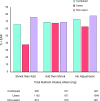Best Practices for Dietary Supplement Assessment and Estimation of Total Usual Nutrient Intakes in Population-Level Research and Monitoring
- PMID: 30753685
- PMCID: PMC6374152
- DOI: 10.1093/jn/nxy264
Best Practices for Dietary Supplement Assessment and Estimation of Total Usual Nutrient Intakes in Population-Level Research and Monitoring
Abstract
The use of dietary supplements (DS) is pervasive and can provide substantial amounts of micronutrients to those who use them. Therefore when characterizing dietary intakes, describing the prevalence of inadequacy or excess, or assessing relations between nutrients and health outcomes, it is critical to incorporate DS intakes to improve exposure estimates. Unfortunately, little is known about the best methods to assess DS, and the structure of measurement error in DS reporting. Several characteristics of nutrients from DS are salient to understand when comparing to those in foods. First, DS can be consumed daily or episodically, in bolus form and can deliver discrete and often very high doses of nutrients that are not limited by energy intakes. These characteristics contribute to bimodal distributions and distributions severely skewed to the right. Labels on DS often provide nutrient forms that differ from those found in conventional foods, and underestimate analytically derived values. Finally, the bioavailability of many nutrient-containing DS is not known and it may not be the same as the nutrients in a food matrix. Current methods to estimate usual intakes are not designed specifically to handle DS. Two temporal procedures are described to refer to the order that nutrient intakes are combined relative to usual intake procedures, referred to as a "shrinking" the distribution to remove random error. The "shrink then add" approach is preferable to the "add then shrink" approach when users and nonusers are combined for most research questions. Stratifying by DS before usual intake methods is another defensible option. This review describes how to incorporate nutrient intakes from DS to usual intakes from foods, and describes the available methods and fit-for-purpose of different analytical strategies to address research questions where total usual intakes are of interest at the group level for use in nutrition research and to inform policy decisions. Clinical Trial Registry: NCT03400436.
Keywords: dietary supplement; measurement error; methodology; total nutrient intakes; usual intakes.
Published by Oxford University Press on behalf of the American Society for Nutrition 2019.
Figures





